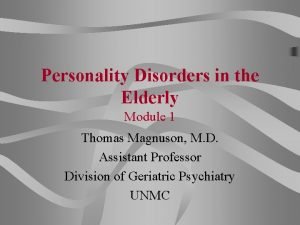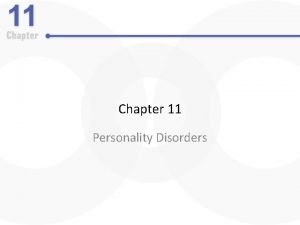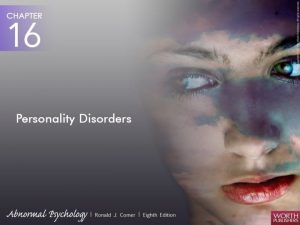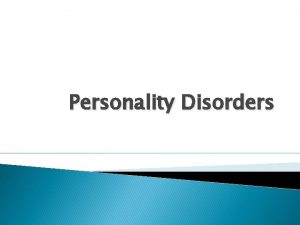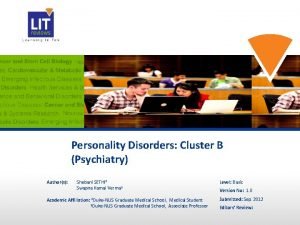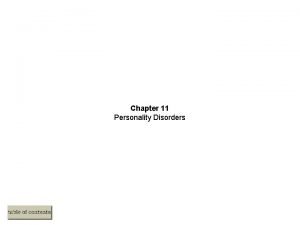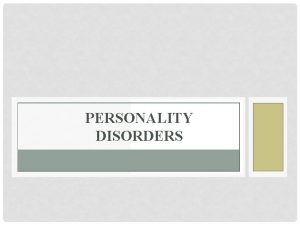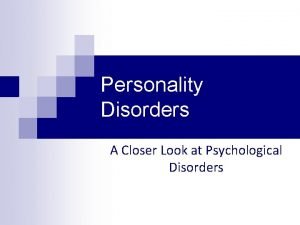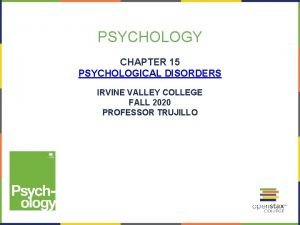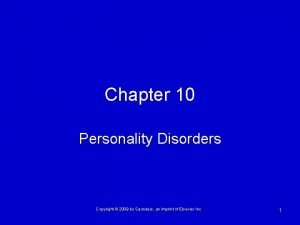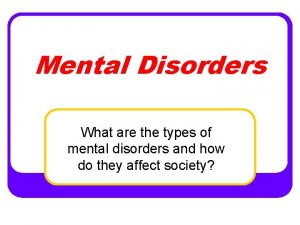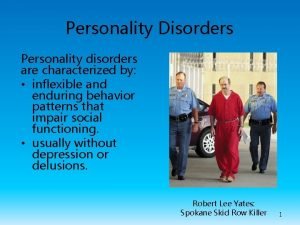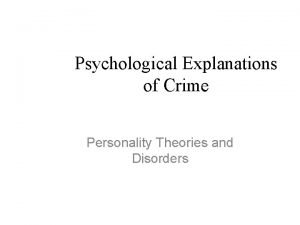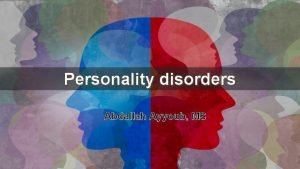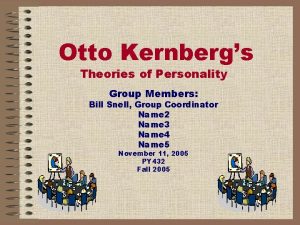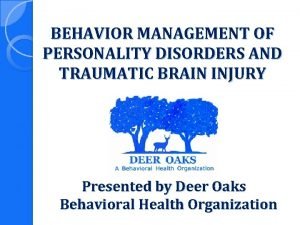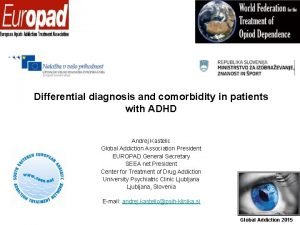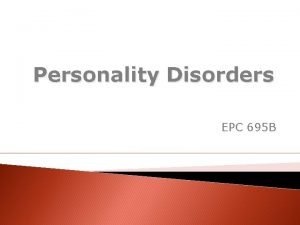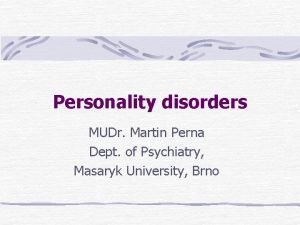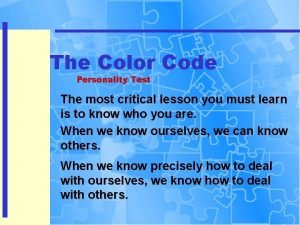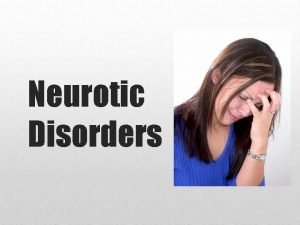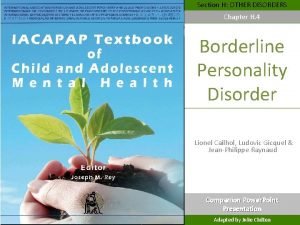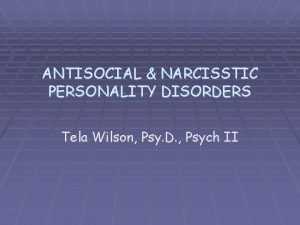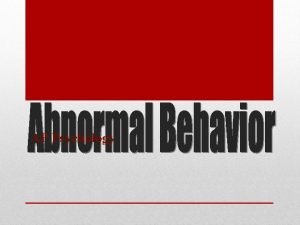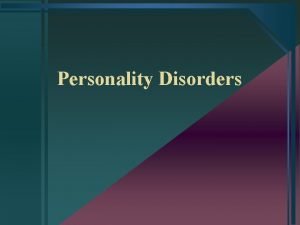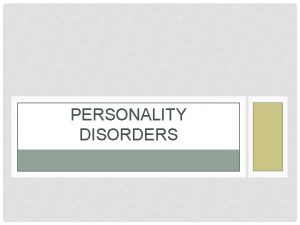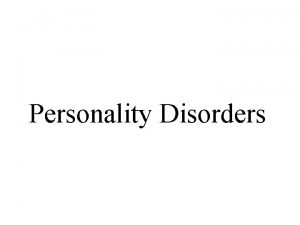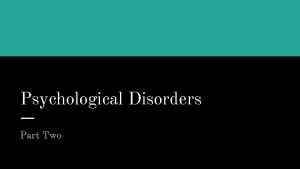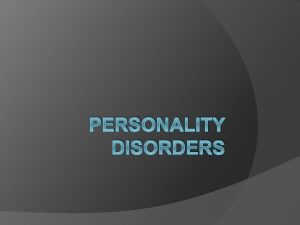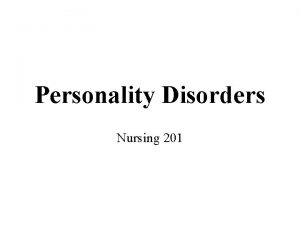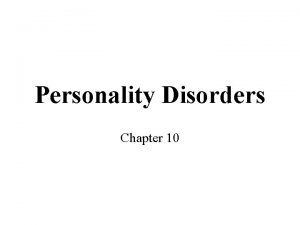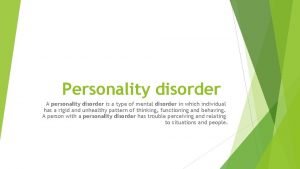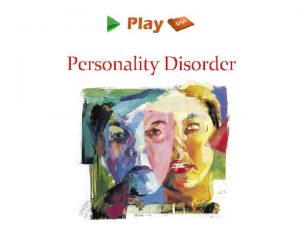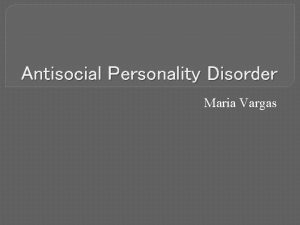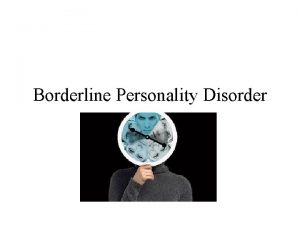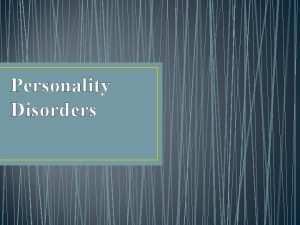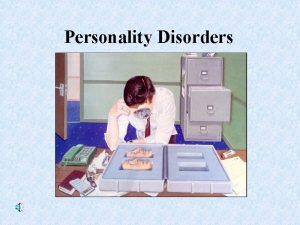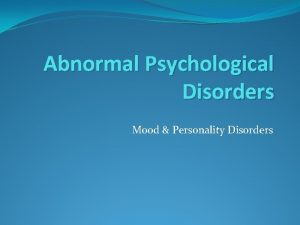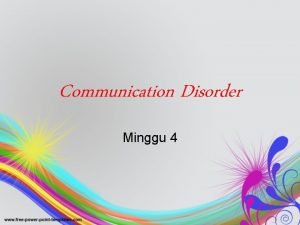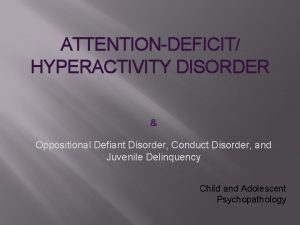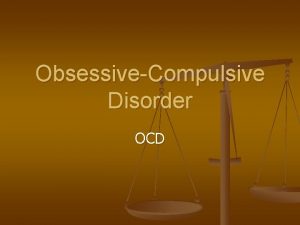Personality Disorders What is personality disorder Personality disorderscauses




























- Slides: 28

Personality Disorders

What is personality disorder?

Personality disorders(causes) Personality- is formed and exists in interaction between hereditary factors and large psychosocial contact Hereditary factors seem to be basic to establish the type of personality Various influences in ontogenetical expierience can modify it.

Definition of Personality n “Enduring patterns of perceiving, relating to, and thinking about the environment and oneself, which are exhibited in a wide range of important social and personal contexts”

Definition of Personality Disorders n Personality disorders are “enduring patterns of perceiving, relating to, and thinking about the environment and oneself” that “are exhibited in a wide range of important social and personal contexts, ” and “are inflexible and maladaptive, and cause either significant functional impairment or subjective distress” (DSM-IV, p. 630)

Main Features of PDs n n n Extreme patterns of thinking, feeling, and behaving that deviate from a person’s culture Listed on Axis II of the DSM-IV-TR Begin early in life and remain stable - not contextual or transient Inflexible and maladaptive Cause significant functional impairment and subjective distress

DSM-IV-TR Personality Disorders Cluster A: Odd or Eccentric n Paranoid Personality Disorder n Schizotypal Personality Disorder Cluster B: Dramatic, Emotional, or Erratic n n Antisocial Personality Disorder Borderline Personality Disorder Histrionic Personality Disorder Narcissistic Personality Disorder Cluster C: Anxious or Fearful n n n Avoidant Personality Disorder Dependent Personality Disorder Obsessive-Compulsive Personality Disorder

Cluster A: Odd or Eccentric n n n Paranoid PD – is a pattern of distrust and suspiciousness such that others’ motives are interpreted as malevolent Schizoid PD – is a pattern of detachment from social relationships and restricted range of emotional expression Schizotypal PD – is a pattern of acute discomfort in close relationships, cognitive or perceptual distortions, and eccentricities of behaviour

Paranoid Personality Disorder n n n suspicious of other’s motives interprets actions of others as deliberately demeaning/threatening expectation of being exploited see hidden messages in benign comments easily insulted/ bears grudges appear cold and serious

Schizoid Personality Disorder n n n indifferent to relationships limited social range (some are hermits) aloof, detached, called loners no apparent need of friends, sex solitary activities seem to be missing the “human part”

Schizotypal Personality Disorder n n peculiar patterns of thinking and behaviour perceptual and cognitive disturbances magical thinking not psychotic n perhaps a distant “cousin” of schizophrenia

Cluster B: Dramatic, Emotional, or Erratic n n Antisocial PD – is a pattern of disregard for, and violation of, the rights of others Borderline PD – is a pattern of instability in interpersonal relationships, self-image, and affects, and marked impulsivity Histrionic PD – is a pattern of excessive emotionality and attention seeking Narcissistic PD – is a pattern of grandiosity, need for admiration, and lack of empathy

Antisocial Personality Disorder n pattern of irresponsibility, recklessness, impulsivity beginning in childhood or adolescence (e. g. , lying, truancy) n adulthood: n n n criminal behaviour little adherence to societal norms, little anxiety conflicts with others callous/exploitive

Psychopathy n n n Egocentric, deceitful, shallow, impulsive individuals who use and manipulate others Callous, lack of empathy Little remorse Thrill-seeking “human predators” (Hare, 1993) No “conscience”

Psychopathy Checklist-Revised (Hare, 1991) – 2 Factors n n n Glib and superficial Egocentric and grandiose Lack of remorse or guilt Lack of empathy Deceitful and manipulative Shallow emotions n n n Impulsive Poor behavior controls Need for excitement Lack of responsibility Early behavior problems Adult antisocial behavior

Borderline Personality Disorder n n n marked instability of mood, relationships, self-image intense, unstable relationships uncertainty about sexuality everything is “good” or “bad” chronic feeling of “emptiness” recurrent threats of self-harm/ “slashers”

Borderline and comorbidity n n High degree of overlap with both Axis I and Axis II disorders 24%-74% also diagnosed with major depression; 4% to 20% bipolar 25% of bulimics also diagnosed with BPD 67% also diagnosed with substance use disorder

Histrionic Personality Disorder excessive emotional displays/ dramatic behaviour n attention-seeking, victim stance n seek re-assurance, praise n shallow emotions, flamboyant, selfcentred n very seductive, “life of the party” n

Narcissistic Personality Disorder n n n grandiose, sense of self-importance lack of empathy hyper-sensitive to criticism exaggerate accomplishments/ abilities special and unique n n entitlement below surface is fragile self-esteem

Cluster C: Anxious or Fearful n n n Avoidant PD – is a pattern of social inhibition, feelings of inadequacy, and hypersensitivity to negative evaluation Dependent PD – is a pattern of submissive and clinging behaviour related to an excessive need to be taken care of Obsessive-Compulsive PD – is a pattern of preoccupation with orderliness, perfectionism, and control at the expense of flexibility

Avoidant Personality Disorder over-riding sense of social discomfort n easily hurt by criticism n always need emotional support n occasionally try to socialize n n so distressing they retreat into loneliness

Dependent Personality Disorder n submissive, clingy behaviour n fear of separation n easily hurt by criticism

Obsessive-Compulsive Personality Disorder excessive control and perfectionism n inflexible n preoccupied with trivial details n judgmental/moralistic n workaholic/ignore family members n often humourless n

Complications -secondary mental illnesses (depression, medicament, drug or alcohole abuse or addiction, eating disorders, impulse-control disorders, anxiety disorders, short psychosis) -suicidal behavior -acts of self-harm -violence and crime behaviour -risk behaviour (sexualy transmitted infections, drug application. . . )

Treatment Motivation to therapy, compliance and efficiency is different from case to case. - Psychoterapy - basis - Pharmacotherapy -in some cases, symptomatic - few controled studies of efficiency - difficult but helpful

Psychoterapy - the choise of the type of psychoterapy depends on specific type of P. D. and other factors as motivation to therapy, intelectual state, age and another. - basic psychoterapeutic support - psychoanalytic: individual or group - cognitive-behavioral therapy

Pharmacotherapy - symptomatic, follows symptoms - target: permanent symptoms (longterm) or actual state (acute anxiety, disquiet, suicidal beh. , agitation, emotional crises. . . )

Pharmacotherapy for symptoms depression- SRI, IMAO, atyp. AP acute anxiety and agitation- BZD, AP anxiety- (S)SRI, buspiron, IMAO, low dose AP em. instability- VAL, CBZ, Li, low dose AP em. flateness- atyp. AP, SSRI, IMAO dysforia- SSRI, low dose atyp. AP aggression- Li, antikonv. , AP impulsivity- SSRI, anticonv. , Li, low dose AP psychotic- AP
 Dsm 5 munchausen by proxy
Dsm 5 munchausen by proxy Cluster c
Cluster c Cluster c personality disorders
Cluster c personality disorders Dramatic personality disorders
Dramatic personality disorders Cluster c personality disorders
Cluster c personality disorders Cluster b personality traits
Cluster b personality traits Cluster c
Cluster c Dsm v personality disorders
Dsm v personality disorders Compulsive personality disorder
Compulsive personality disorder Diathesis stress model
Diathesis stress model Cluster b personality disorders
Cluster b personality disorders Cluster c personality disorders
Cluster c personality disorders Psychological disorders characterized by inflexible
Psychological disorders characterized by inflexible Carla homulka
Carla homulka Cluster b
Cluster b Weird wild wacky personality disorders
Weird wild wacky personality disorders Margaret mahler stages
Margaret mahler stages Hierarki adalah
Hierarki adalah Obsessive compulsive personality disorder symptoms
Obsessive compulsive personality disorder symptoms Adhd and borderline personality disorder
Adhd and borderline personality disorder Nos personality disorder
Nos personality disorder Codependent personality disorder
Codependent personality disorder Color code personality
Color code personality Neurosis disorder
Neurosis disorder Adhd and borderline personality disorder
Adhd and borderline personality disorder Tela wilson
Tela wilson Ap psychology abnormal behavior
Ap psychology abnormal behavior Personality disorder vs mental illness
Personality disorder vs mental illness Personality trait disorder
Personality trait disorder

